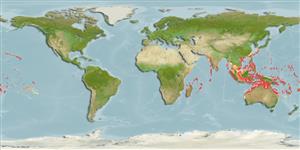>
Tetraodontiformes (Puffers and filefishes) >
Balistidae (Triggerfishes)
Etymology: Melichthys: Greek, melas, melaina, melan, black + icthys yos, fish. On the other hand, in Smith et al.,1986: 878), 'body dark brown to black' in https://www.biodiversitylibrary.org/item/266635#page/902/mode/1up.(P. Romero, pers.comm. 03/2022)..
More on author: Richardson.
Environment: milieu / climate zone / depth range / distribution range
Ökologie
seewasser riff-verbunden; tiefenbereich 0 - 60 m (Ref. 1602). Tropical; 32°N - 31°S, 30°E - 132°W
Indo-Pacific: East Africa eastward through northern Australia to Hawaiian and Tuamotu islands, north to southern Japan.
Size / Gewicht / Alter
Maturity: Lm ? range ? - ? cm
Max length : 40.0 cm TL Männchen/unbestimmt; (Ref. 30573)
Rückenflossenstacheln (insgesamt): 3; Rückenflossenweichstrahlen (insgesamt): 31-35; Afterflossenstacheln 0; Afterflossenweichstrahlen: 28 - 31. Juveniles with dark lines radiating from eye and dark lines on anal and soft dorsal fins (Ref. 4420).
Occur in seaward reefs to depths greater than 60 m (Ref. 9710, 48637), with rich invertebrate growth (Ref. 48637). Common in coral-rich areas exposed to currents (Ref. 1602). Usually at moderate depths in small loose groups (Ref. 48637). Benthopelagic (Ref. 58302). Diet consists mainly of algae and detritus but also takes in crustaceans, octopuses, sponges, and fishes (Ref. 1602). Oviparous (Ref. 205). Also taken with drive-in nets. Marketed fresh (Ref. 9770). Minimum depth reported taken from Ref. 128797.
Life cycle and mating behavior
Geschlechtsreife | Fortpflanzung | Ablaichen | Eier | Fecundity | Larven
Oviparous, distinct pairing during breeding (Ref. 205).
Matsuura, K., 2001. Balistidae. Triggerfishes. p. 3911-3928. In K.E. Carpenter and V. Niem (eds.) FAO species identification guide for fishery purposes. The living marine resources of the Western Central Pacific. Vol. 6. Bony fishes part 4 (Labridae to Latimeriidae), estuarine crocodiles. FAO, Rome. (Ref. 9770)
IUCN Rote Liste Status (Ref. 130435)
Bedrohung für Menschen
Harmless
Nutzung durch Menschen
Fischereien: weniger kommerziell; Aquarium: Kommerziell
Mehr Information
ReferenzenAquakulturAquakultur ProfilZuchtlinienGenetikElectrophoresesVererbbarkeitKrankheitenVerarbeitungNutrientsMass conversion
Tools
Zusatzinformationen
Download XML
Internet Quellen
Estimates based on models
Preferred temperature (Ref.
123201): 24.6 - 28.9, mean 27.6 °C (based on 692 cells).
Phylogenetic diversity index (Ref.
82804): PD
50 = 0.6250 [Uniqueness, from 0.5 = low to 2.0 = high].
Bayesian length-weight: a=0.02692 (0.01580 - 0.04584), b=3.05 (2.90 - 3.20), in cm total length, based on LWR estimates for this species & (Sub)family-body (Ref.
93245).
Trophic level (Ref.
69278): 3.4 ±0.39 se; based on food items.
Widerstandsfähigkeit (Ref.
120179): mittel, Verdopplung der Population dauert 1,4 - 4,4 Jahre. (Preliminary K or Fecundity.).
Fishing Vulnerability (Ref.
59153): Low to moderate vulnerability (30 of 100).
Nutrients (Ref.
124155): Calcium = 37.2 [15.6, 91.1] mg/100g; Iron = 0.564 [0.291, 1.260] mg/100g; Protein = 18.4 [16.3, 20.6] %; Omega3 = 0.114 [0.057, 0.220] g/100g; Selenium = 37.6 [19.9, 77.0] μg/100g; VitaminA = 49.9 [14.5, 176.1] μg/100g; Zinc = 0.987 [0.674, 1.461] mg/100g (wet weight);
